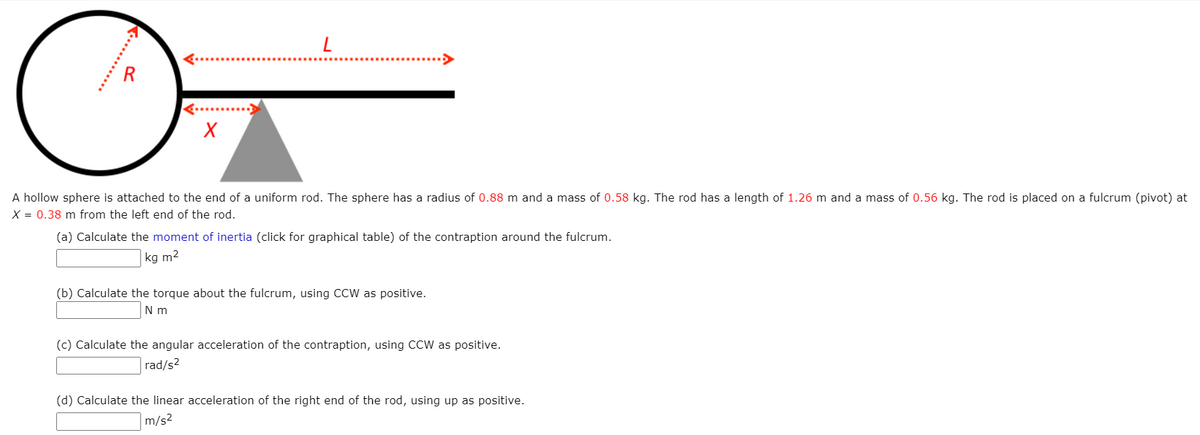A hollow sphere is attached to the end of a uniform rod. The sphere has a radius of 0.88 m and a mass of 0.58 kg. The rod has a length of 1.26 m and a mass of 0.56 kg. The rod is placed on a fulcrum (pivot) at X = 0.38 m from the left end of the rod. (a) Calculate the moment of inertia (click for graphical table) of the contraption around the fulcrum. |kg m² (b) Calculate the torque about the fulcrum, using CCW as positive. N m (c) Calculate the angular acceleration of the contraption, using CCW as positive. rad/s2 (d) Calculate the linear acceleration of the right end of the rod, using up as positive. m/s2
A hollow sphere is attached to the end of a uniform rod. The sphere has a radius of 0.88 m and a mass of 0.58 kg. The rod has a length of 1.26 m and a mass of 0.56 kg. The rod is placed on a fulcrum (pivot) at X = 0.38 m from the left end of the rod. (a) Calculate the moment of inertia (click for graphical table) of the contraption around the fulcrum. |kg m² (b) Calculate the torque about the fulcrum, using CCW as positive. N m (c) Calculate the angular acceleration of the contraption, using CCW as positive. rad/s2 (d) Calculate the linear acceleration of the right end of the rod, using up as positive. m/s2
Principles of Physics: A Calculus-Based Text
5th Edition
ISBN:9781133104261
Author:Raymond A. Serway, John W. Jewett
Publisher:Raymond A. Serway, John W. Jewett
Chapter10: Rotational Motion
Section: Chapter Questions
Problem 65P: A long, uniform rod of length L and mass M is pivoted about a frictionless, horizontal pin through...
Related questions
Question

Transcribed Image Text:A hollow sphere is attached to the end of a uniform rod. The sphere has a radius of 0.88 m and a mass of 0.58 kg. The rod has a length of 1.26 m and a mass of 0.56 kg. The rod is placed on a fulcrum (pivot) at
X = 0.38 m from the left end of the rod.
(a) Calculate the moment of inertia (click for graphical table) of the contraption around the fulcrum.
kg m2
(b) Calculate the torque about the fulcrum, using CCW as positive.
N m
(c) Calculate the angular acceleration of the contraption, using CCW as positive.
rad/s2
(d) Calculate the linear acceleration of the right end of the rod, using up as positive.
m/s2
Expert Solution
This question has been solved!
Explore an expertly crafted, step-by-step solution for a thorough understanding of key concepts.
This is a popular solution!
Trending now
This is a popular solution!
Step by step
Solved in 4 steps

Knowledge Booster
Learn more about
Need a deep-dive on the concept behind this application? Look no further. Learn more about this topic, physics and related others by exploring similar questions and additional content below.Recommended textbooks for you

Principles of Physics: A Calculus-Based Text
Physics
ISBN:
9781133104261
Author:
Raymond A. Serway, John W. Jewett
Publisher:
Cengage Learning

Physics for Scientists and Engineers
Physics
ISBN:
9781337553278
Author:
Raymond A. Serway, John W. Jewett
Publisher:
Cengage Learning

Physics for Scientists and Engineers with Modern …
Physics
ISBN:
9781337553292
Author:
Raymond A. Serway, John W. Jewett
Publisher:
Cengage Learning

Principles of Physics: A Calculus-Based Text
Physics
ISBN:
9781133104261
Author:
Raymond A. Serway, John W. Jewett
Publisher:
Cengage Learning

Physics for Scientists and Engineers
Physics
ISBN:
9781337553278
Author:
Raymond A. Serway, John W. Jewett
Publisher:
Cengage Learning

Physics for Scientists and Engineers with Modern …
Physics
ISBN:
9781337553292
Author:
Raymond A. Serway, John W. Jewett
Publisher:
Cengage Learning

Glencoe Physics: Principles and Problems, Student…
Physics
ISBN:
9780078807213
Author:
Paul W. Zitzewitz
Publisher:
Glencoe/McGraw-Hill

University Physics Volume 1
Physics
ISBN:
9781938168277
Author:
William Moebs, Samuel J. Ling, Jeff Sanny
Publisher:
OpenStax - Rice University

Physics for Scientists and Engineers: Foundations…
Physics
ISBN:
9781133939146
Author:
Katz, Debora M.
Publisher:
Cengage Learning